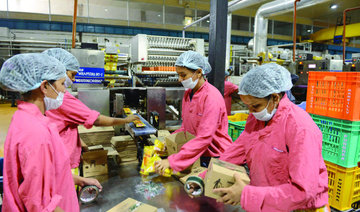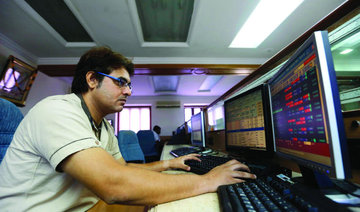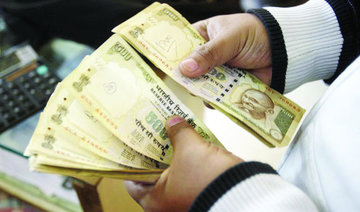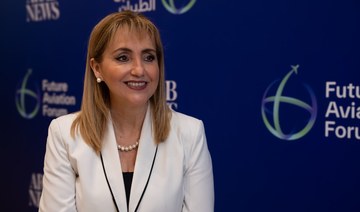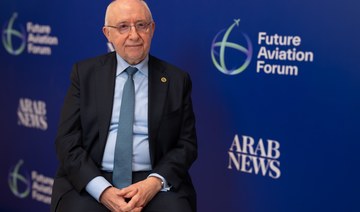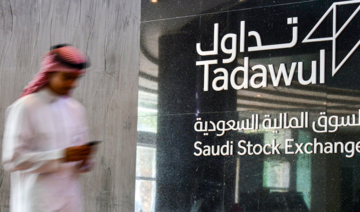NEW DELHI: India called on Friday for more monetary easing as it flagged risks to economic growth and budget targets, citing a series of disinflationary impulses weighing on Asia’s third-largest economy.
In its mid-year economic survey, the Finance Ministry said “tighter” monetary policy meant real interest rates in India were substantially higher than in comparable emerging economies, further clouding the economic outlook.
Faster monetary easing, the ministry argued, would help deleverage corporate balance sheets and restore banks’ profits, helping the economy realize its full potential.
While it retained an official growth forecast of 6.75 percent to 7.5 percent for the fiscal year to March 2018, the report highlighted a stronger rupee, deepening farm distress and a disruption in business activity following the launch of a new sales tax, as headwinds.
“There has been an across-the-board deceleration,” said chief economic adviser Arvind Subramanian, the survey’s author. “It is less likely than before that we will reach the upper end of the range.”
Growth slowed to 6.1 percent in the March quarter, its lowest in more than two years, following monetary reform ordered by Prime Minister Narendra Modi last November to purge high-value banknotes from circulation.
The subsequent launch of a national Goods and Services Tax (GST) has caused chaos on the ground as ambiguous rules have left firms confused on how to price their products.
In a sign of things to come, business surveys showed both services and manufacturing contracting at their fastest rate in years in July, the month that the GST was launched.
Disinflationary pressures allowed the Reserve Bank of India (RBI) last week to cut its main policy rate — the first easing by an Asian central bank this year — by 25-basis points to 6 percent.
Yet Subramanian, Finance Minister Arun Jaitley’s top economic adviser, said the policy repo rate was still 25-75 basis points above the neutral rate.
Although he did not fault the RBI’s new inflation-targeting framework, he did question the approach of its Monetary Policy Committee.
“Both expected inflation and GDP (gross domestic product) are subdued relative to their equilibrium levels,” the survey said. “The conclusion is inescapable that the scope for monetary easing is considerable.”
Even as the RBI resumed cutting rates, it warned inflation could accelerate to as high as 4.5 percent in October-December. The economic survey, however, took the view that India’s inflation, which cooled to a record low of 1.54 percent in June, is undergoing a “structural shift.”
It expects headline inflation to remain below the RBI’s medium-term target of 4 percent through to the end of March 2018 on the back of normal summer rains and the deflationary impact of farm loan waivers.
Four Indian states including Uttar Pradesh, which has a population bigger than Brazil’s, have agreed to waive billions of dollars in farm loans to offer relief to farmers reeling from losses caused by bad weather.
Subramanian said the loan waivers were likely to be deflationary as the states would have to either raise taxes or cut spending to keep their budget deficits in check.
Indian government flags growth risks and pushes for monetary easing
Indian government flags growth risks and pushes for monetary easing
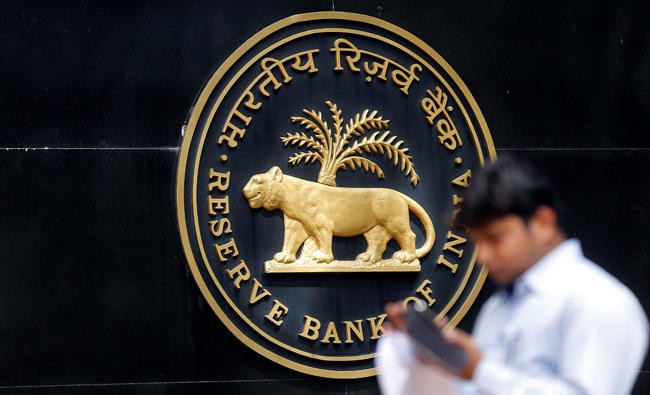
Saudi Arabia rises 9 spots in WEF’s global tourism index

RIYADH: Saudi Arabia has climbed nine spots to rank 41 on a global tourism index – marking the Gulf region’s largest improvement – thanks to its strengthening infrastructure, corporate presence, and major business centers.
According to the World Economic Forum’s Travel & Tourism Development Index report, Saudi Arabia has recorded the most significant improvement in the Middle East and North Africa region since 2019.
The WEF’s TTDI, covering 119 economies, measures the set of factors and policies enabling the sustainable and resilient development of the tourism and travel sector, which, in turn, contributes to a country’s development.
The report highlighted that the tourism sector in high-income economies within the region, particularly the Gulf Cooperation Council, benefited from several factors. These included high-quality infrastructure, such as major aviation hubs and leading airlines, the presence of large corporations and significant business centers driving travel activities, and a favorable business environment.
“In part, these efforts are reflected in broad increases in government T&T spending as a share of budgets, loosened visa requirements, improvements in the establishment and promotion of cultural resources, and the highest regional average for T&T capital spending per employee in the index,” the report added.
In the index, the UAE stands out as the top performer in the region overall and the Middle East subregion, ranking 18th. Meanwhile, Egypt, with a ranking of 61st, stands out as the top scorer in the North Africa subregion, the report revealed.
The US, Spain, and Japan hold the top three positions in the index with no change in ranking from 2019. Meanwhile, France and Australia have climbed two ranks each from 2019 to secure the fourth and fifth positions. Germany and the UK also feature in the top 10 but with a minor fall in their positions to sixth and seventh in 2024 compared to 2019. China, Italy, and Switzerland hold the remaining three positions in the top 10.
The WEF findings also pointed out that travel and tourism activities in developing economies in the region often face challenges, including less attractive business environments, safety and security concerns, and gaps in the necessary transport and tourism infrastructure.
Furthermore, many countries in the region have implemented policies and invested substantial resources to develop the tourism and travel sector. This effort aims to diversify their economies and reduce dependency on the oil and gas industry, according to the report.
Saudi Arabia is set to unveil a new tourism strategy later this year, leveraging artificial intelligence and seamless technology, Gloria Guevara Manzo, chief special adviser at the Ministry of Tourism, told Arab News on the sidelines of the Future Aviation Forum.
She added that the plan aims to enhance the Kingdom’s cultural, historical, and hospitality assets.
In 2023, Saudi Arabia’s travel sector surpassed expectations, prompting a revision of its Vision 2030 targets from 100 million to 150 million visits by 2030.
Additionally, the Kingdom has introduced regulatory changes, such as the “Visiting Investor” visa and the expansion of the GCC unified visa service, to attract more international visitors and investors.
Major projects like NEOM, Riyadh Air, and the Red Sea Project are central to these efforts, aiming to make tourism a significant revenue source by 2030.
The WEF also noted that the tourism and travel sector in the region would benefit from reducing travel and trade restrictions and making significant investments in environmental sustainability to support future improvements in natural resources.
However, it warned that the recent escalation of regional conflicts and the resultant increase in safety and security concerns pose a major external risk to future tourism development.
ICAO summit in Riyadh shows recognition of Saudi Arabia’s role in aviation sector: GACA president
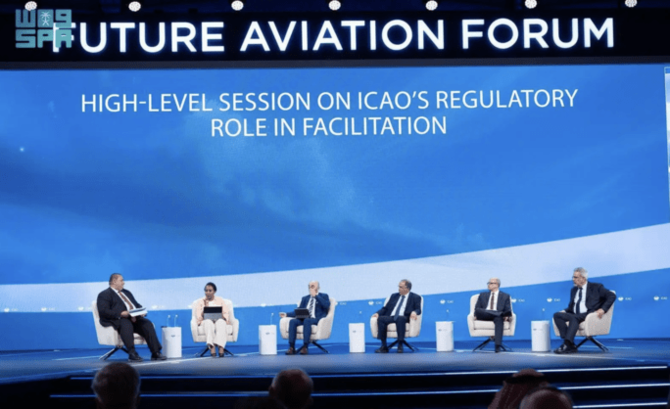
RIYADH: The decision of the International Civil Aviation Organization to host its Facilitation Global Summit in Riyadh underscores Saudi Arabia’s leading position in the sector, an official said.
Abdulaziz Al-Duailej, president of the Kingdom’s General Authority of Civil Aviation, noted that Riyadh’s selection to host the summit also recognizes the Kingdom’s outstanding contributions to the international civil aviation community.
The ICAO Facilitation 2024 Global Summit was launched in Riyadh on May 21, in conjunction with the Future Aviation Forum being held in the Saudi capital.
During the event’s opening speech, Al-Duailej highlighted that the summit is an opportunity to share various initiatives GACA has implemented in the Kingdom to elevate the passenger experience.
The gathering includes 30 speakers and more than 500 aviation experts and specialists who will discuss the industry’s opportunities and challenges.
The GACA president further noted that the authority has implemented a monitoring and inspection program to ensure that Saudi international airports comply with the standards and recommendations outlined in ICAO’s Annex 9 directives.
“Annex 9 — Facilitation is based on 10 articles of the Chicago Convention which require that the civil aviation community comply with laws governing the inspection of aircraft, cargo and passengers by authorities concerned with customs, immigration, agriculture and public health,” according to the ICAO website.
It added: “Under the Convention, States are obligated to adopt standards and expedite the necessary formalities in order to minimize operational delays.”
Al-Duailej pointed out that Saudi Arabia is cooperating with international aviation authorities and continuing its investments in advanced safety technologies to provide passengers transiting the Kingdom’s airports with a smooth travel experience.
For his part, Salvatore Sciacchitano, president of ICAO, said that the summit will empower aviation mechanisms globally.
Speaking to Arab News on May 21, Sciacchitano said that Saudi Arabia is a “model” for sustainable practices in the aviation sector, as the Kingdom’s growth in the industry aligns with global standards.
He also predicted that global air traffic will reach 11.5 billion by 2050, up from the current 4.6 billion.
Sciacchitano added that the technological revolution will accelerate the aviation sector’s growth, allowing the world to accommodate more airplanes in the sky and more space on the ground.
GCC banks’ net profit surge 10.5% to 14.4bn: Kamco Invest
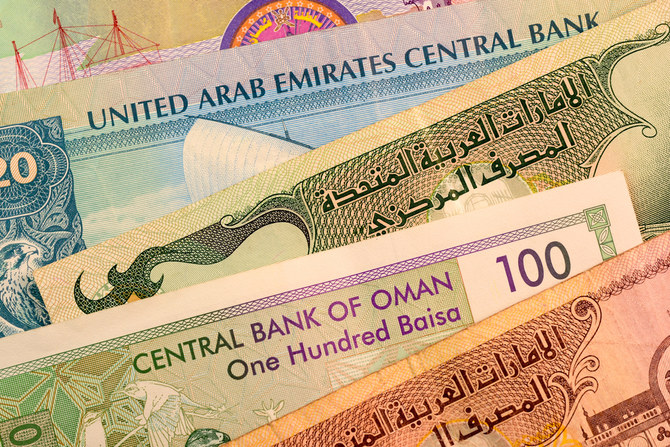
RIYADH: Net profit of banks in the Gulf Cooperation Council region surged by 10.5 percent year-on-year in the first quarter of 2024 to $14.4 billion, an analysis showed.
In its latest report, Kamco Invest said that the bottom line performance of these banks also witnessed a rise of 11.8 percent in the first quarter compared to the previous three months.
The study added that an increase in lending continued in the region despite higher borrowing costs.
“The strong growth came despite a fall in revenues during the quarter and reflected a fall in total operating expenses coupled with a steep fall in quarterly impairments,” said the asset management company.
According to the analysis, banks in Saudi Arabia registered the most robust growth in the first quarter of 2023 at 3.3 percent, while gross credit data for UAE banks showed an increase of 1.1 percent during the first two months of the year.
“Data on listed banks showed gross loans reaching a record high of $2.02 trillion at the end of the first quarter of 2024, registering a quarter-on-quarter growth of 1.8 percent while aggregate net loans reached $1.92 trillion after a sequential growth of 2.3 percent,” the report added.
Kamco Invest revealed that customer deposits grew at a much stronger pace during the quarter as depositors eyed higher interest income.
The report noted that total customer deposits in the GCC region reached $2.45 trillion at the end of the first quarter after witnessing the most extensive quarter-on-quarter growth in for a year at 2.8 percent.
However, in the first quarter, the total revenue of listed banks in the GCC region fell for the first time in 12 quarters to $31.4 billion due to the impact of elevated interest rates.
According to the analysis, the first quarter registered a flattish gain in total interest income, reaching $50.5 billion, with the yield on credit averaging at 4.3 percent, in line with the trend over the last three quarters.
However, the continued rise in interest expenses, which reached $29.3 billion for the quarter, more than offset the growth in interest income
On the other hand, aggregate non-interest income declined for the first time in six quarters during the first quarter to reach $10.2 billion, from $10.7 billion in the last three months of 2023.
“Non-interest income also witnessed a decline during the quarter after a fall in other interest income more than offset a growth in management fees and commission income during the first quarter of 2024,” the report added.
Saudi point-of-sale spending drops 6.9%: SAMA data

RIYADH: Saudi Arabia’s point-of-sales spending registered a 6.9 percent decline in the third week of May, compared to the previous seven days, reaching SR11.65 billion ($3.11 billion), official figures showed.
The latest data from the Saudi Central Bank, also known as SAMA, revealed that spending on beverages and food, which accounts for the largest share at 15 percent, saw a 9.3 percent decline, reaching SR1.77 billion, during the week from May 12 to 18.
Meanwhile, transactions at restaurants and cafes, holding a 14.8 percent share, recorded a slower decline of 5.4 percent, amounting to SR1.73 billion.
Saudi spending on miscellaneous goods and services, which include personal care items, supplies, maintenance, and cleaning, constituted the third-highest share and witnessed a 7.1 percent decline in that week, reaching SR1.44 billion.
Despite comprising only 1 percent of the week’s overall POS value, spending on education recorded the largest decline, dropping 23.2 percent to SR152.33 million.
In recent years, this sector has received the highest proportion of government spending compared to other areas of the economy. The education system is being overhauled to better prepare the national workforce to compete in an increasingly technology- and information-driven global economy.
The telecommunications sector experienced the second-largest decline in POS transaction value, dropping 10.1 percent to SR95 million.
According to data from SAMA, approximately 35 percent of POS spending occurred in Riyadh, with the total transaction value reaching SR4.04 billion. However, this represents a 5.4 percent decrease from the previous week.
Riyadh has experienced significant expansion, becoming a central hub for growth and development. Numerous new businesses are establishing operations in the city, attracted by its dynamic economic environment and strategic opportunities for investment and innovation.
Spending in Jeddah followed closely, accounting for around 14 percent of the total and reaching SR1.65 billion; however, it marked a 6.2 percent weekly decline.
The two cities that registered the highest declines in POS spending were Hail and Tabouk, with decreases of 10.5 percent and 10.4 percent, respectively. The value of transactions in Hail reached SR176 million, while in Tabouk it was SR221 million.
Oil Updates – crude slips for third session on likely ‘higher for longer’ US rates

SINGAPORE: Oil prices fell for a third straight session on Wednesday on expectations the Federal Reserve might keep US interest rates higher for longer due to sustained inflation, potentially impacting fuel use in the world’s largest oil consumer, according to Reuters.
Brent crude futures were down 71 cents, or 0.9 percent, to $82.17 a barrel, while US West Texas Intermediate crude futures slipped 73 cents, or 0.9 percent, to $77.93 as of 9:50 a.m. Saudi time.
Oil prices settled about 1 percent lower on Tuesday.
Fed policymakers said on Tuesday the US central bank should wait several more months to ensure that inflation really is back on track toward its 2 percent target before cutting interest rates.
Higher borrowing costs can slow economic growth and pressure oil demand.
US crude oil and gasoline inventories rose last week, while distillates fell, according to market sources citing American Petroleum Institute (API) figures on Tuesday.
Ahead of this weekend’s Memorial Day holiday, which kicks off the US peak summer driving season, retail gasoline prices fell for the fourth consecutive week. US prices of diesel, a key refined product for both the industrial sector and transport, have also slipped.
Investors are awaiting minutes from the Fed’s last policy meeting and weekly US oil inventory data from the US Energy Information Administration due later on Wednesday.
“The Federal Open Market Committee minutes will be scrutinized for Fed’s assessment of bumpy Q1 inflation and clues on the timing and extent of potential interest rate cuts in 2024,” ANZ analysts said in a report.
“It’s more of a wait and see ‘what the data is telling us’ approach,” ANZ said.
The eurozone has all but promised a rate cut on June 6 amid more positive economic outlook. European Central Bank President Christine Lagarde said in an interview aired on Tuesday that she was “really confident” eurozone inflation was under control.


